The phenomenon called "the water cycle in nature" can be called one of the most important atmospheric processes for the existence of the planet. Without it, the life of people, animals and plants is impossible. This is a fairly simple and understandable action, which is already being explained to small children in kindergarten and primary school.
Children of different ages are asked to draw this phenomenon as they understand it, in order to see all the stages of the process more clearly. For older children, the phenomenon is considered in more depth, taking into account small details and additional nuances of what is happening.
What you need for drawing
The water cycle in nature (the picture can be drawn with pencils) is a very interesting natural phenomenon, which is studied in detail in natural history lessons at school. To draw the water cycle in nature, it is necessary to understand the basic principles of what is happening and prepare everything necessary to transfer the studied information to a sheet of paper.
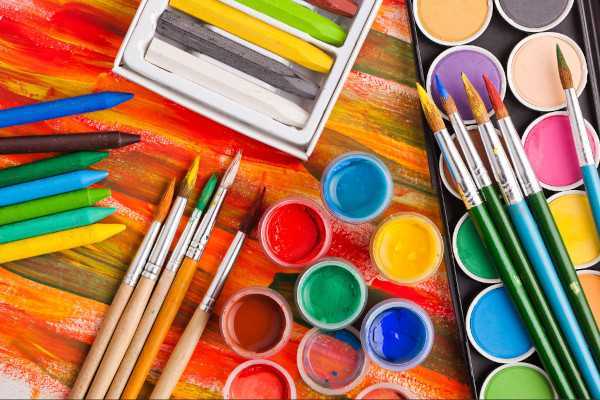
To draw it you need to prepare the necessary materials:
| Drawing paper | It is necessary to select a sheet of suitable size and texture depending on the chosen plot. When painting with oil paints, it is better to use canvas, when working with watercolors and acrylic - paper. |
| Paints | The choice of paints depends on personal preferences. You can choose watercolors, oil or acrylic paints. |
| Brushes | The shape and size of the brushes affect the creation of different textures, shapes and effects. Watercolor and oil paints require soft and thin brushes, acrylic paints require hard brushes. |
| Palette knives or art spatula | Used to create different textures and water effects. To mix or remove excess paint that has not dried. To clean the palette and apply thick paint to the canvas. |
| White gouache and acrylic paint | It is needed to add light iridescence and highlights on the water. |
| Clear varnish | Can be used to add shine and protect the design from external damage. |
| Straight and decorative ruler | For drawing straight lines or ovals of regular shape. For a rough sketch of the placement of the drawing relative to its shape. |
| Eraser | It is needed to remove unnecessary details of the preliminary drawing. |
| Pencils, plain and colored | A simple pencil will be needed for a rough sketch. Colored pencils can be used to color the finished drawing. |
The water cycle in nature (the picture can be painted with paints) can be drawn by a child even in kindergarten. First, you need to choose a suitable and interesting plot for the drawing. It depends on preferences and skills, on the ability to draw small and large details. The picture can become an illustration of various natural processes.
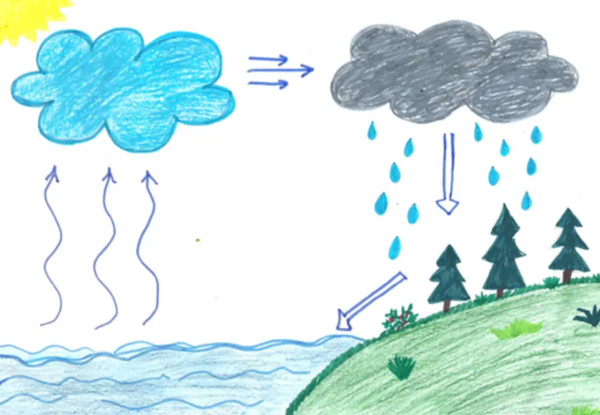
Water can be depicted in different forms: from powerful waterfalls to calm lakes. You can draw the water cycle in calm large or small reservoirs, in mountain springs or turbulent streams. You can depict heavy rain or rare snowflakes falling from the sky.
It is important to understand the features of the water cycle in nature in the chosen plot.
You need to use your observation and visualization to record the actions:
- water movement;
- forms of water disturbance;
- the play of shadows and light on the surface of the water.
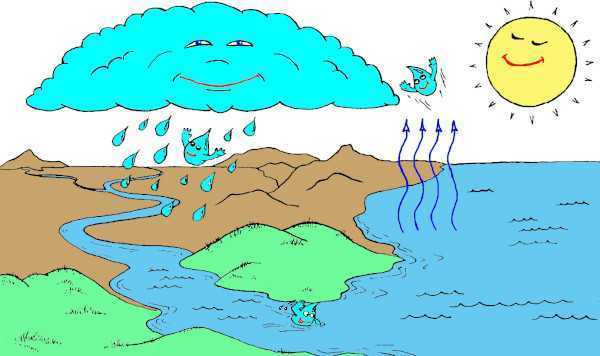
Before you start working, you need to prepare the work surface, this will help create a high-quality and expressive picture. Before you start drawing, you need to choose the right texture and color of paper, because the background shade can greatly affect the overall impression of the whole picture.
The painting will look best on a sky-blue background or in light green, this will help to give an additional feeling of freshness and purity. Before starting work, you need to prepare the necessary pencils or paints.
To depict moving water, you can use colors:
- blue;
- violet;
- white.
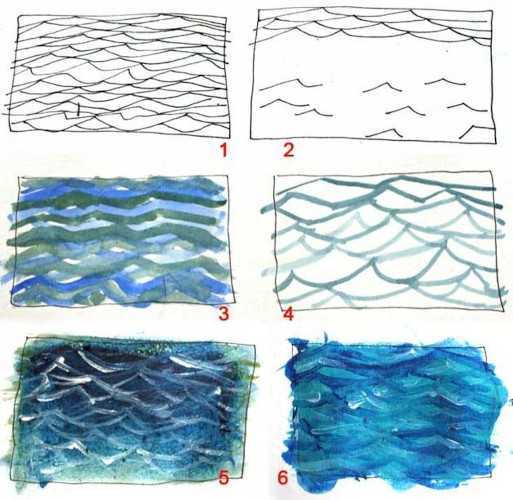
To draw small details or add contrast, you may need brown and black pencils. For convenience, you can fix the sheet of paper on the table with tape or adhesive tape, this way you will avoid deformation of the sheet.
To simplify the task, you can conditionally divide the working surface of the sheet into several parts using a ruler. This action will make it easier to control the application of the composition and the arrangement of elements in the water cycle in nature.
How to draw a simple water cycle in nature
The water cycle in nature (the drawing can be drawn schematically, simple or more complex, with an explanation of the small details of what is happening) is the process of continuous movement of water across the planet.

It occurs in several stages, starting from the evaporation of water to its fallout as precipitation and runoff back into water bodies. All processes occur between the atmosphere and the Earth's surface. Thanks to this, the water balance in nature is maintained.
The main stages of the water cycle in nature are:
- water evaporates from the surface of soil and water bodies;
- is transferred into the atmosphere as water vapor;
- water condenses and subsequently forms clouds;
- falls as precipitation, in the form of snow or rain;
- enters rivers, lakes and soil;
- returns to the oceans and seas.
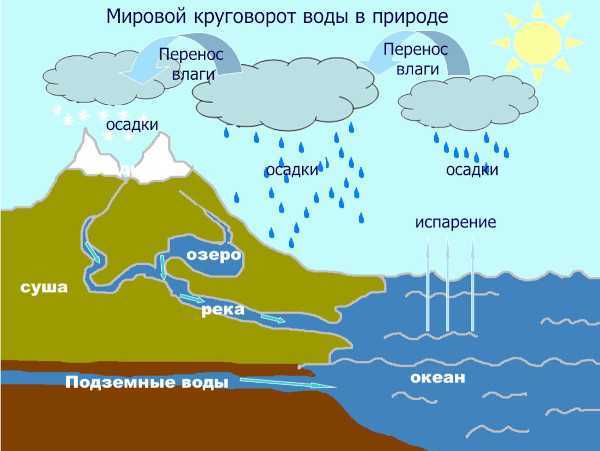
To draw the water cycle in nature, you need to mark all the main elements of nature that are associated with water. In the middle of the sheet of paper, you need to draw a reservoir using curved arc lines that convey the image of moving water.
Near the pond, for a more natural perception of the plot, you can draw plants. The placement of stones and bushes near the pond will help make the image more realistic.
You can add small hills to the drawing, which can serve as a support for the water cycle process, so that the water flows down from the hills. Also, draw abundant vegetation and trees that should grow near the reservoir.

This will help to give the image volume and depth. To give the drawing a sense of variety and naturalness, it is best to draw plants and trees of different sizes and shapes.
The next step is to give the drawing realistic lighting and atmosphere by depicting clouds and the sun in the sky. It is advisable to draw clouds of different sizes and shapes, the sun can be depicted as a large bright circle.
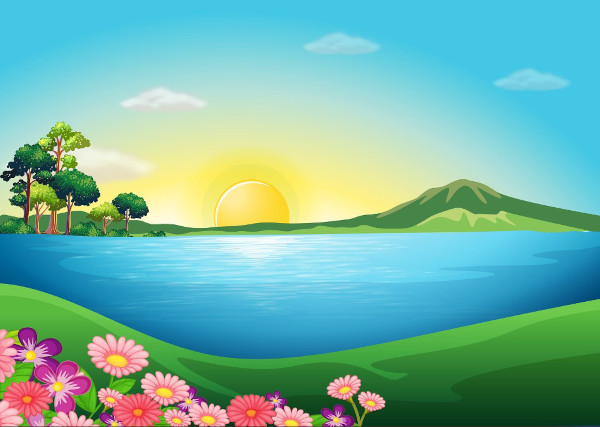
It is advisable to add small details to the finished landscape, such as fish in the water, birds in the sky or fishermen in a boat. If desired, you can supplement the drawing with various minor elements that will add beauty to the image.
Shading water to depict movement
After applying the main elements to the drawing, you should begin adding details and shading the image. By applying shading, you can create and achieve the effect of water movement in a swirl.
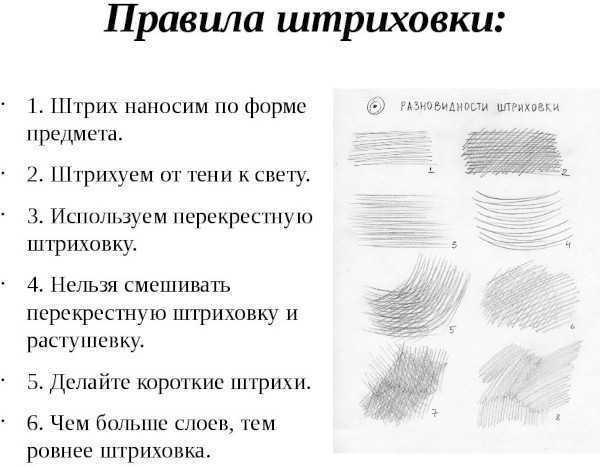
You can use oblique strokes directed inward into the circle. Applying this type of shading will help create the impression of movement and swirl. They can be applied with light and rhythmic movements of the brush, repeating the shape of the water cycle.
Another way to do this is to apply smooth wavy strokes, which can serve as an excellent basis for depicting waves and water flows. To achieve the effect of free movement of water, you can use different sizes and different directions of strokes.
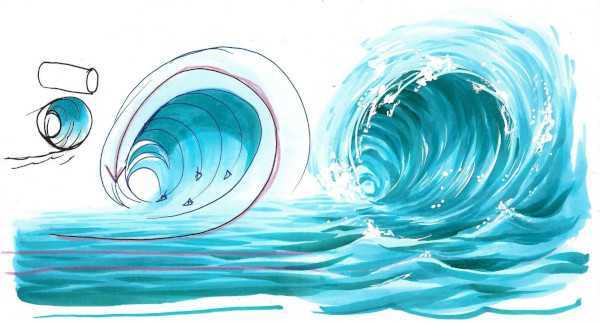
To convey the different speed and direction of water in different areas, you will need to use both short and long strokes. Short and energetic strokes will indicate active and fast sections of the reservoir, calm and smooth strokes - slow sections of the river.
Color transitions to add depth
Proper color transitions from dark to light and vice versa will add depth to the drawing. To do this, it is necessary to ensure a smooth transition from one color to another. This effect can be created on a pond by applying dark blue in the center of the drawing with a gradual transition to the edges with a lighter shade.
For this, you can use a wide brush, a special pencil or mediums for mixing colors. For a more realistic image, you should take into account that the depth effect may vary depending on the state of the water. In still water, it will be less noticeable and smoother.
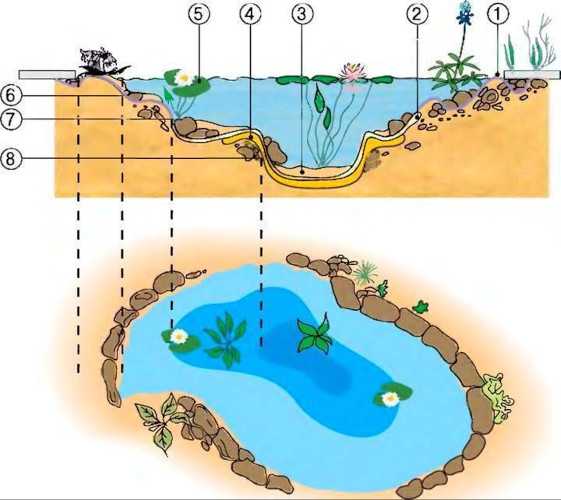
In a turbulent stream of water, the color transition should be made sharper and more dynamic. For a more interesting result, you need to try experimenting with different shades and, along with a schematic image of the water cycle in nature, try to correctly recreate its beauty.
Additional details in the drawing of the water cycle in nature
To convey the activity of water as accurately as possible, you can try to study in practice the formation of waves and how water hits the shore. To convey the effect of water fluidity, you will need to draw soft and smooth lines with a wide brush.
You can show how light is reflected from water by showing a smooth transition from a light shade to a dark one in the drawing.
A drawing on the theme of "Water Cycle in Nature" can be drawn using artistic details that make the picture as picturesque as possible. To convey the natural landscape most realistically, you need to add additional details to the drawing in the form of waves or splashes of water, this will help show the movement and strength of the water flow.
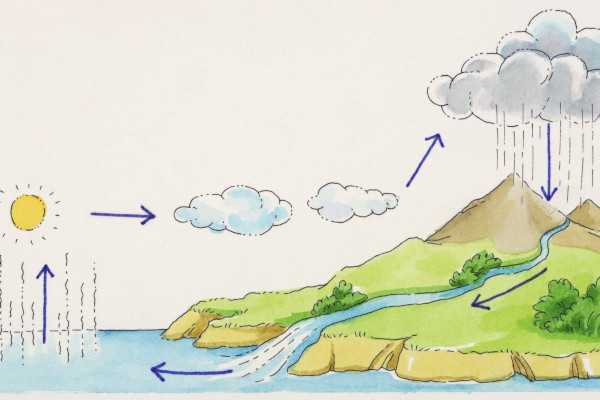
There are different ways to draw foam and splashes. One of the simplest is to use the technique of dot application of paint. At the same time, for a more realistic image, you can use gouache and watercolor paints, the correct choice of shade is important, it should be light blue or white.
To apply the splash and foam effect, you will need a thin brush with very soft bristles. The paint should be applied with precise movements in areas where water separations should be visible; these details will add volume to the painting.
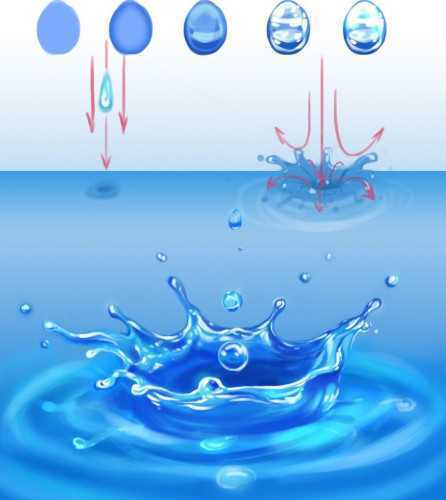
To add more realism, you can use light and shadow techniques, applying light dots in places where the light falls on the foam and splashes at a certain angle.
This technique will help to achieve lightness and get the effect of translucency. When drawing, you need to consider that splashes and foam can have different structures and sizes, they can be changed using contours.
The effect of transparency and reflection in the drawing of the water cycle in nature
The water cycle in nature (the drawing can be done using the creation of the effect of transparency and reflection) you need to draw, following the instructions step by step:
- Apply a base coat of paint to the drawing using light shades of blue and green. The closer to the body of water, the more saturated the color should be.
- Add basic wave shapes on the water surface using darker tones of the same shades. The waves should be connected and have a natural shape.
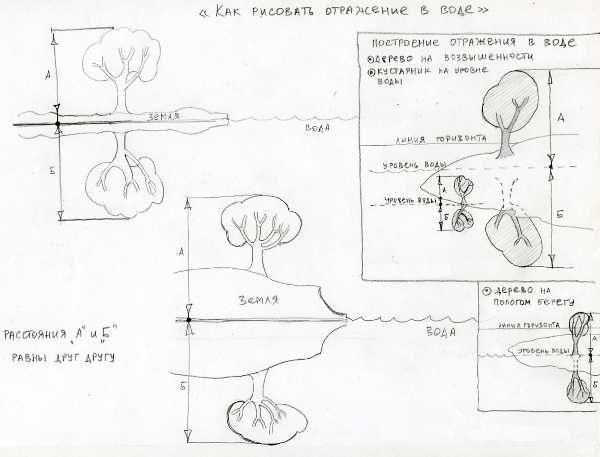
- To achieve a transparent effect, use a blurry brush and blend light and dark colors at the edge of the waves. This will help create the illusion of light penetrating through the water.
- To achieve the most realistic effect, you need to display images of objects and natural elements on the calm surface of the reservoir in the water. To do this, you need to use darker shades so that they stand out against the background of the water.
Completing the drawing of a water swirl in nature
After the main elements have been applied to a sheet of paper, the painting should be given more realism.

To do this, you need to follow the steps below:
- Add shades to the water to make it look voluminous. To do this, use light and dark shades of blue, blue and green.
- Light shades should be applied to the surface of the water in a place where the light should fall directly.
- Gradually move on to dark shades, applying them to the surface in areas where shadows from other objects are visible.
- Apply stripes on the water surface using blurred circular motions using a brush with soft bristles or a sponge, thus creating the illusion of water movement.
- Using white or light blue paint, draw small drops of water on plant leaves, rocks or other surfaces near the pond.
- All too sharp and clear outlines should be blurred with a brush and a small amount of water.
- The drawing should indicate precipitation in the form of rain or snow, which is how water, after evaporation, returns to the earth's surface and into water bodies, completing the cyclical nature of what is happening.

The effect of the water cycle in nature is of great importance for maintaining the ecological system of the planet and maintaining biological diversity in the world. Thanks to this process, water is supplied to different regions for the formation and maintenance of the life cycle of different creatures.
The closed natural cycle plays a major role in the climate regulation of the Earth, is the basis for water supply for people and maintaining agriculture. Using the example of the process drawing, you can understand in detail how water circulates on the planet and what a big role it actually plays.
Author: Olga Zhanskaya
Video about the water cycle in nature
Drawing the water cycle in nature:
